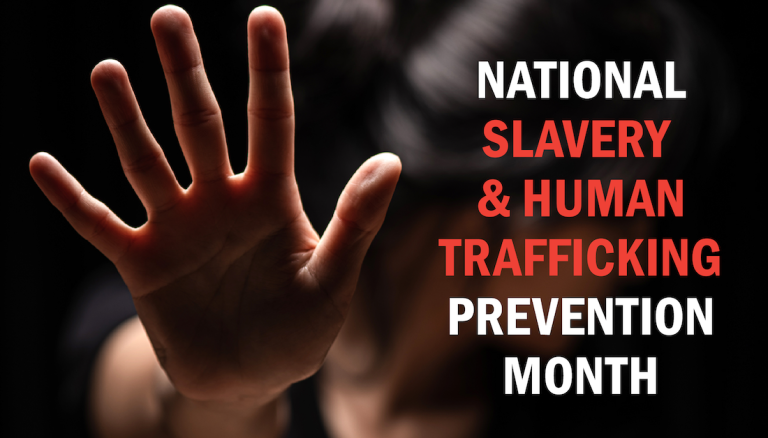
Special Monthly Feature: January
New York, N.Y. — Every January, the United States unites in a powerful observance: National Slavery and Human Trafficking Prevention Month. This annual initiative, marked by a presidential proclamation since 2010, is a beacon of hope and action against one of the world’s most pervasive human rights violations.
As we step into 2025, this month-long campaign continues to inspire individuals, communities, and organizations to raise awareness, support survivors, and combat modern slavery in all its forms.

The origins of this vital observance trace back to a pivotal moment in U.S. history.
In 2010, President Barack Obama first declared January as National Slavery and Human Trafficking Prevention Month, building on the foundation laid by the Trafficking Victims Protection Act of 2000 (TVPA). The TVPA marked a turning point, enshrining the nation’s commitment to fighting human trafficking both domestically and globally.
Since then, each U.S. president has reaffirmed this dedication through annual proclamations, spotlighting the ongoing struggle and celebrating milestones in the fight against exploitation. From the 2012 Executive Order strengthening protections against trafficking in federal contracts to the 2017 launch of the U.S. State Department’s Program to End Modern Slavery, these proclamations reflect a growing resolve to eradicate this crime.
Human trafficking— modern slavery—
remains a global crisis, affecting an
estimated 27 million people worldwide
But why does this month matter so much?
Human trafficking—often called modern slavery—remains a global crisis, affecting an estimated 27 million people worldwide, including thousands in the United States. It takes many forms: forced labor in factories or farms, sexual exploitation, and even domestic servitude.
Victims span all ages, genders, and backgrounds, often lured by false promises of jobs or safety, only to be trapped by force, fraud, or coercion. In 2025, the need for awareness is more urgent than ever, as economic instability and digital platforms create new vulnerabilities for exploitation.
National Slavery and Human Trafficking Prevention Month shines a light on these hidden injustices, reminding us that this is not a distant problem—it’s happening in our communities.
The importance of this observance lies in its dual mission: education and empowerment.
By dedicating January to this cause, governments, nonprofits, and citizens come together to share knowledge about the signs of trafficking—such as restricted movement, fearfulness, or unexplained injuries—and the resources available to help. It’s a time to honor survivors, whose resilience inspires change, and to recognize the tireless efforts of advocates and law enforcement working to dismantle trafficking networks.
In 2024 alone, the U.S. Department of Justice’s National Strategy to Combat Human Trafficking aligned with the Biden administration’s National Action Plan, emphasizing prevention, prosecution, and victim protection. This month amplifies those efforts, fostering a collective commitment to a freer, safer world.
How can it help? The impact is tangible.
Awareness campaigns during this month connect victims to critical services like the National Human Trafficking Hotline (1-888-373-7888), which offers confidential support 24/7. Educational initiatives equip communities to spot and report suspicious activity, disrupting trafficking before it escalates.
For example, the U.S. Department of Homeland Security’s Blue Campaign encourages everyone to “Wear Blue” on January 11—National Human Trafficking Awareness Day—to show solidarity and spread the word. By fostering partnerships across sectors, from businesses to faith groups, this observance builds a network of support that empowers survivors to rebuild their lives and holds perpetrators accountable.
The positive ripple effects extend beyond January.
Each conversation sparked, each donation made, and each volunteer hour spent strengthens the movement. Organizations like Hope for Justice report that awareness leads to action—whether it’s a teacher noticing a student’s distress or a bystander reporting a tip.
In 2025, the theme from the Administration for Children and Families, “Activate Connections to Prevent Human Trafficking,” underscores the power of collaboration. When we connect, we protect.
Shining Light on National Slavery, Human Trafficking Prevention Month (Jan. 2, 2025)
#EndHumanTrafficking #SlaveryPrevention
#WearBlueDay #HumanTraffickingAwareness
Tags: Human trafficking, modern slavery, prevention month,
awareness campaign, survivor support, Blue Campaign, call to action,
National Slavery and Human Trafficking Prevention Month

So, what can you do? Start small, but act boldly. Educate yourself about trafficking signs through resources like the Blue Campaign website. Share a post with #EndHumanTrafficking to amplify the message.
Volunteer with local anti-trafficking groups or donate to survivor support services. Even a simple act—like wearing blue on January 11—can spark a conversation that saves a life.
Together, we can turn awareness into action, making 2025 a turning point in the fight against modern slavery. Join the movement today—because every step forward brings us closer to freedom for all.